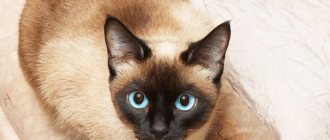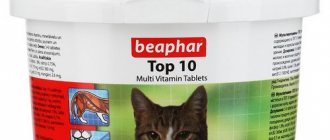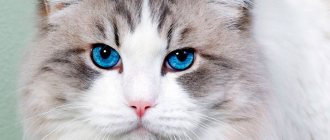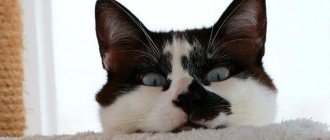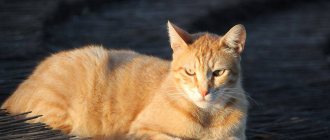Siberian
Representatives of this breed are the most popular in Russia. This is due to the beautiful appearance of the animal and its absolute safety for allergy sufferers. The Siberian cat does not cause allergic reactions, despite its long and thick fur. Its hypoallergenicity is caused by a low concentration of the Fel D1 protein, which is responsible for allergic reactions.
Representatives of this cat breed are distinguished by a calm and balanced character. They are affectionate, gentle and friendly, making them suitable for families with small children.
Read more about the Siberian cat breed
Russian blue
Appearance. The calling card of the Russian Blue is its unique wool.
She is short, with a dense undercoat. Color: all shades of blue. Cats of this breed have exclusively emerald eyes. Character. An affectionate, flexible animal, but you won’t be able to control it. Russian Blues don't like to be submissive. If the owner tries, he will be able to establish a trusting relationship with the pet.
These cats are very inquisitive and playful, they will happily frolic with children, but they will not tolerate other animals in the house. They tolerate loneliness calmly.
Care. The Russian Blue is a clean and fastidious animal. You need to wash your pet's tray and bowl regularly. Cats do not require special care. Mandatory procedures: combing (once a week), cleaning ears and teeth.
Ragdoll
Are you interested in what is the most popular cat breed with a gentle and affectionate character? Pay attention to the ragdoll. Cats and cats of this breed are suitable for those people who need to constantly take care of someone. The Ragdoll will follow its owner and expect care and affection from him. This is one of the largest and fluffiest breeds, which is why it gained its popularity. Such an unusual name for a furry pet is due to its gentle character and ability to relax in the owner’s arms, like a “rag doll.”
Such cats easily get along with the smallest children and show them affection and care. Even during play, they never release their claws, and therefore do not pose a danger.
Read more about the Ragdoll breed
History and modernity of the shorthair cat
Cats are perhaps the most mysterious animals domesticated by humans. They have been living next to us for at least ten thousand years - around then the factor of artificial selection joined the natural evolution of species. People, according to their needs and tastes, began to form different cat populations in individual territories, improving, as they needed, the natural qualities of cats and using genetic mutations.
One of the six hundred cat statues found in the Temple of Bast in Alexandria
When a person began to lead a sedentary lifestyle, engage in farming and stockpile food, he needed an assistant to fight rodents encroaching on the crop. Scientists believe that various wild animals were used for this purpose, for example, genets or representatives of mustelids - ferrets. But cats, thanks to their intelligence and good human orientation, have pushed all competitors far away.
Scientists have conducted large-scale DNA studies of domestic cats from around the world, and based on data from almost a thousand pets, they have established that all modern “murks” have a common ancestor - the steppe cat. This wild species is widespread on the planet and is called Felis silvestris lybica in Latin. The animal with short striped hair, domesticated at least ten thousand years ago, gave rise to the entire variety of modern breeds.
The steppe cat, the progenitor of the domestic cat, still lives in the wild
Surely there were attempts to domesticate other species of the cat family - but they were not so successful. This, for example, is evidenced by recent finds by archaeologists in Central China. The remains of domestic cats found here date back to approximately the 4th millennium BC and have different genetics. It is assumed that the Chinese tried to domesticate Prionailurus bengalensis, a Bengal cat, but this experiment was not widespread.
Features of domestic cats with short hair
The broad concept of short-haired cats includes breeds whose fur length does not exceed 2.5 cm along the body and may be slightly longer in some areas, such as the tail. Cat fur varies significantly in texture - here we can distinguish the following options:
- short with a predominance of awns (Thai cat);
- short with developed undercoat (chartreuse);
- short hard (American shorthair cat);
- short wavy (Rex breed group);
- short smooth (Bombay cat);
- short without undercoat (oriental);
- hair of “hairless” cats (a group of sphinxes and breeds derived from them).
There are a lot of cat breeds - there are plenty to choose from to suit your taste and color
Sphynxes are also short-haired cats (with the exception of homozygous individuals), they have a soft, often almost invisible downy coat, which becomes longer in the cold season.
British Shorthair
Representatives of this noble breed have a long history. It is believed that it was brought to England by the Romans in the first century AD. Many years later, the British Shorthair cat was crossed with the Persian. The result was a new breed with a thicker coat and slightly modified appearance. It is in this form that the representative of the breed is known today.
"British" are very smart and loyal animals. They do not impose their company, they do not always even allow themselves to be stroked, it all depends on their mood. These pets can be alone for long periods of time. Because of this personality trait, they are called “business cats.” For this reason, "British" cats are the most popular cats among business people.
Read more about the British Shorthair cat breed
The most popular cat breeds. Top 20 (with photos)
19th place. Burmese cat (Burmese) . The short-haired breed is native to Southeast Asia. In Burma (modern name Myanmar), such cats were kept in Buddhist temples and were considered the reincarnation of deceased monks.
see also Buddhist Cats
18th place. The Siberian cat is a famous Russian breed of semi-long-haired cats, which got its name due to its place of origin - Siberia.
17th place. The Tonkinese cat is a hybrid of the American-type Siamese and Burmese cats.
16th place. Russian Blue . The breed traces its origins to the cats of the ancient Slavs. This breed became known outside Russia in 1893, when the English breeder Karen Cox brought two blue kittens from Arkhangelsk. The main distinguishing feature of the breed is its short blue coat with a beautiful silver tint. Russian Blue is one of the most expensive cat breeds.
15th place. The Burmese cat (sacred Burmese) is a breed of semi-long-haired cat that originates from Burma (Myanmar). It should not be confused with the Burmese cat, which is a separate breed of short-haired cat. The Burmese cat is recognizable due to its unusual color, which is called the Burmese color after the name of the breed. Cats with this color are characterized by the presence of white “gloves” with the point color of long hair.
14th place. The Norwegian Forest Cat is a breed of domestic semi-longhaired cat originally from Norway. The breed's ancestors were ship's cats on Viking longships.
13th place. Cornish Rex . A short-haired breed of domestic cat originally from Great Britain. The main distinguishing feature of the Cornish Rex is their coat. It has no guard hairs, and the undercoat is curled into a dense wave, reminiscent of astrakhan fur in structure.
12th place. The Siamese cat is a breed originally from Thailand (its old name is Siam).
11th place. The Devon Rex is a breed of short-haired domestic cat that originated in Great Britain. Representatives of this breed have a very extraordinary appearance: their fragile body is covered with soft curly hair, and their head is decorated with huge ears.
10th place. Oriental cat (oriental) . This shorthaired breed's ancestors are from Thailand, but it officially originated in the United States.
9th place. The Canadian Sphynx is a breed of hairless cat whose history officially began in 1966 in Canada, but there is evidence that these unusual creatures were known back to the times of the Egyptian pharaohs and were common in the Aztec and Incas temples in ancient Mexico.
8th place. The Abyssinian cat is one of the oldest cat breeds. Abyssinia is the former name of Ethiopia, where this breed originates.
7th place. The Scottish Fold (or Scottish Fold) is a very interesting breed of cat, the main distinguishing feature of which is the characteristic structure of the ears, curved forward and down. This unusual detail of their appearance is a consequence of a gene mutation. The first representative of this breed was discovered in 1961 in Scotland.
6th place. American shorthair cat . The ancestors of this breed were brought by the first settlers from Europe to North America.
5th place. British shorthair cat. This breed is the most popular in the UK.
4th place. Ragdoll is a breed of semi-long-haired cat. The name of the breed is translated as “rag doll”, because. Ragdolls phlegmatically accept any actions towards them: they can be stroked, squeezed, or put in certain positions.
3rd place. The Maine Coon is a large breed of domestic cat whose ancestors lived on the farms of Maine (Northeast America). Due to their original black striped color and large fluffy tail, they looked like raccoons - hence the second part of the name “coon”, that is, “raccoon”.
see also The largest breeds of domestic cats
2nd place. Persian cat . The ancestors of the modern breed were taken from Persia (modern name Iran) to Italy in the 17th century. In 2012 and 2013, the Persian cat was the most popular breed in the world, but in the last two years it has been content with only second place.
1 place. The exotic cat (exotic cat) is a breed of shorthair cat artificially created by American breeders in the 1960s by crossing American shorthair cats with Persian cats. In 2014 and 2020, exotics managed to surpass in popularity even their long-haired ancestors - Persian cats.
see also The rarest cat breeds
American Shorthair
Representatives of this popular breed of pets are very playful and carefree, but at the same time they always maintain their independence. They do not impose their society and demand the same from the owner. The cat loves to be around, but is extremely rarely held in your arms; this happens only at its request. Even in domestic conditions, the breed retains its predatory instinct and loves to hunt mice.
The American Shorthair cat easily survives the long absence of its owner. Such a four-legged friend is acquired by people who spend a lot of time at work and often travel on business trips.
Read more about the American Shorthair breed
Siamese cat
An angel on the outside and a little devil on the inside - this is a short portrait of the most popular cat in Russia: the Siamese. She is obstinate, temperamental and stubborn, and will not leave her owner until she gets her way. Siamese also have a very loud voice, which can irritate people who love peace and tranquility in their home.
But you forgive them everything for their incredibly beautiful blue eyes and charming soft black-fawn fur.
Scottish lop-eared
This is an independent, aristocratic and noble animal with a beautiful appearance. For his comfortable stay in the house, it is necessary to allocate a place that no one will touch.
Despite their independent disposition, “Scots” are very playful and active, so they should have their own toys. Because of their love of play, they get along well with children, but they are not affectionate. You can pet a Scottish cat only if she wants it.
Read more about the Scottish Fold breed
Munchkin
Muncchins are very unusual - they have short legs. They come in long-haired and short-haired varieties.
Description
Elongated and muscular body, short legs, wide head, large eyes. The color is different.
The Munchkin is a friendly and playful pet. There is absolutely no aggression. Ideal for families with children. They love to walk in the fresh air.
Care
Standard care. Feeding on ready-made super premium food or high-quality natural products. Animals tend to be overweight.
Price from 5,000 rubles.
Munchkin
Burmese
The breed combined the beauty, nobility and grace of a wild animal originally from ancient Asia. They are rightfully considered home psychologists, because they easily adapt to any mood of the owner and know how to communicate with him.
The main advantage of the Burma is its thick and long coat. The most popular animal color options:
- rich gray with a blue tint;
- brown;
- cream;
- lilac.
Burmese are born completely white. As kittens grow older, they acquire their own unique coloration.
By nature, Burmese cats are calm, balanced, with a sense of self-esteem. It is important for breeders to know that this breed does not know how to land correctly on its feet, so it is necessary to ensure that the pet does not climb to heights.
Smooth-haired Egyptian Mau
The Egyptian Mau are sacred in Egypt. And these animals got their name because they can clearly pronounce this sound.
Description
The animals have a compact and graceful body, medium-sized ears and a wedge-shaped head. The eyes are almond-shaped, decorated with black arrows.
The peculiarity of the eye color of the Egyptian Mau is that from 8 months to one and a half years of age they are the color of young gooseberries, and after that they are only green.
The Egyptian Mau has a slightly amazed look. A distinctive feature of the Egyptian Mau is its naturally spotted color. The spots are distinct and round.
The character is balanced, at a young age they are distinguished by great energy. They are very attached to their owner and household members. But they are wary of strangers.
Care
- Brush your pet once a week;
- bathe periodically;
- get the necessary vaccinations.
Choose your Mau's food carefully because there are animal allergens. It is best to use super premium food.
The price from the Egyptian Mau in nurseries is from 25,000 rubles and above.
Egyptian Mau
Persian
Smart, calm, phlegmatic, kind, affectionate – these are the main character traits of the animal. Despite outward calm and even indifference, “Persians” become strongly attached to their owner, love him and are devoted to him. The Persian cat never imposes its company, but always happily accepts affection and games.
Representatives of the breed may be different in relation to children. Some Persian cats adore babies, literally allowing them everything, while others show grandeur and arrogance.
Read more about the Persian cat breed
Oriental
These cats are related to Siamese cats and come from Thailand. They come in short-haired and long-haired varieties.
Description
Long, lean body, graceful neck, wedge-shaped head and elongated chin. Almond-shaped eyes. Big ears.
An Oriental cat has a wide range of colors, but its eyes must be green. This is a sign of the breed.
These cats are very attached to their owner and suffer from loneliness, but at the same time they are very touchy. They do not like to sit still - they are very active. They are thermophilic and tolerate travel well.
Care
Standard care. Food is suitable both ready-made and natural. The main thing is that it is balanced, since cats tend to be overweight.
The price depends on the class of the animal and the purpose of the purchase.
The cost of a pet starts from 5,000 rubles. Exhibition animals are much more expensive.
Oriental
Selkirk Rex
By nature, this is a very calm, balanced, predictable and smart cat. From the breeds that were used to breed the subspecies, the Selkirk Rex inherited the following traits:
- softness and tenderness - from Persian;
- restraint and patience - from the British;
- playfulness - from exotic.
These most popular cat breeds in the world have given the Selkirk Rex a unique character and amazing appearance. These cats make good companions. Representatives of the breed are ideal for large families with children.
The cat requires constant and careful care. The animal cannot cope with thick curly hair on its own, so it needs to be washed and combed regularly.
Pixiebob
Pixiebobs are rare and have a short tail. They were obtained by crossing a domestic cat and a lynx.
Description
Muscular body, pear-shaped head, large ears and almond-shaped eyes.
Pixiebob is an active and playful cat. Needs constant contact with household members. Devotees.
Care
They love water procedures very much. Feeding on ready-made super premium food or high-quality natural products.
Price from 20,000 rubles.
Pixiebob
Maine Coon
This is a calm, intelligent and independent cat. The breed comes from large cats living in the northern states of the USA. These wild animals were a natural population in those areas.
The most important distinguishing feature of the Maine Coon's character is its independence. The cat may not allow the inhabitants of the apartment to approach him, not allow him to be stroked, and even more so, to impose his will. At the same time, representatives of the breed are very gentle and kind towards children and play well with older children.
The Maine Coon is one of the largest cat breeds in the world and requires plenty of space to live at home.
Read more about the Maine Coon breed
Peterbald
Also known as the Peterbald Sphynx, the Peterbald is another hairless Russian cat breed. This was the result of an experimental cross between the Don and Siamese breeds, which resulted in the breed retaining the hairless characteristics of the Don and the body, head and eye shape of the Siamese or Oriental Shorthair breeds. The Peterbald is typically an affectionate, good-natured cat that is also intelligent and energetic. At home he gets along well with family, small children and other animals.
Bengal
The Bengal cat is independent, but at the same time gentle, sociable and affectionate. The breed was artificially bred from wild Asian cats in the USA in 1991.
Animals of this breed are distinguished by an unusual, unique tricolor color. Their head is black, red and white, their body is white with red, brown and black spots. In appearance, such a pet resembles a leopard, from which it inherited its independent disposition. Despite living at home, pets remain strong and agile predators.
Read more about the Bengal cat breed
These most popular cat breeds in Russia and in the world can become your pets, companions and true friends.
Abyssinian cat
Abyssinians have long, slender legs, and their coat is short and lies close to the body. Their appearance is reminiscent of the graceful figurines of ancient Egyptian cats. And this is not surprising, because the ancestors of Abyssinian cats, according to researchers of this breed, lived in the territory of ancient Egypt.
Abyssinians are affectionate, loyal to children, and usually get along well with other pets. Known for their curiosity, playfulness and need to explore their environment, these animals are completely people-oriented and love to participate in the activities happening around them.
Features of caring for short-haired cats
Caring for short-haired cats is very easy. Absent or minimal human intervention in the formation of the breed makes such animals healthy and hardy.
Of course, there are breeds that are more prone than others to certain hereditary pathologies (for example, the Scottish Fold is characterized by osteochondrodysplasia, that is, improper development of bones and cartilage tissue, it is this defect that causes sagging ears), but these diseases are in no way related to the length of the coat .
The floppy ears of the Scottish Fold are the result of congenital problems with cartilaginous tissue.
By and large, the short hair of pets does not require special care. However, this does not mean that such cats do not shed! The amount of fluff flying around the house where a cat lives does not depend on the length of its fur (the only difference is the length of the hairs that settle on the furniture). Therefore, animals with short hair can and even need to be combed, it’s just that this procedure has slightly different goals.
Short-haired cats shed just as much as long-haired cats.
Brushing a long-haired cat is necessary for the health of the animal itself. Ungroomed fur gets tangled and becomes a real breeding ground for parasites. In addition, regular licking of long hair is fraught with gum inflammation and even intestinal blockage.
Swallowed fur forms clumps in the cat's stomach and can clog the intestines.
With short hair, no matter what overly active enthusiasts say, a cat is quite capable of coping on its own. But periodic combing allows you to remove dead hairs in a timely manner, thus reducing their spread throughout the house. A light massage is also beneficial for the animal’s skin, improves blood circulation in it and strengthens the coat, preventing excessive hair loss. Finally, many cats experience great pleasure from brushing, so it can be a good opportunity for emotional intimacy between pet and owner.
Many cats love brushing
In conclusion, a few more words about molting. In the wild, cats usually change their coat twice a year: by winter the animal grows a thick undercoat, and in the spring, on the contrary, it changes its coat to a lighter one. However, in domestic cats forced to spend the winter in a warm and dry room, these processes become disrupted over time, and as a result, molting can turn into a sluggish, ongoing process. There is nothing wrong with this (however, providing cool and moist air in the apartment in winter is useful not only for the cat, but also for other household members).
Spending the entire winter on the battery, the cat loses the sense of the seasons and begins to shed constantly
At the same time, excessive shedding can be a warning sign. Intense hair loss often accompanies various diseases (both skin and internal organs), as well as problems with the emotional state of the animal.
Excessive shedding may be a result of stress.
My Thai cat lost hair in huge quantities in the last years of her life. Neither combing, nor even vacuuming, which the beast really liked, solved the problem: the hair simply did not stick to the poor old woman’s skin. But with the young Abyssinian it was more interesting. She loved my daughter so much that when she left, she literally began to shed her fur. When trying to pet the animal, tufts of zone-colored hairs remained in the hands. But as soon as the daughter returned, the painful molting miraculously stopped right before our eyes.
Cats always shed a lot when they get old.
Thus, by the quality of the coat you can always judge the physical and psychological state of the cat. It is not without reason that when preparing breeding animals for exhibitions, special attention is paid to the wool: it is washed, combed, fluffed, polished, etc. in a special way. If your pet is constantly losing its hair, you should definitely take a closer look at it: perhaps the animal is sick or something upset, scared. But if the animal is active and cheerful, and hair loss is minor, there is nothing to worry about. Brushing is not a mandatory part of caring for short-haired cats and remains at the complete discretion of the parties - the cat itself and its owner.
I also cannot help but note that non-shedding hairless cats are not at all a convenient replacement for “wool” cats. The unnatural absence of hair creates such problems for both the pet itself and its owner that shedding may seem like a mere trifle in comparison. By the way, the current opinion that hairless cats are hypoallergenic has nothing to do with reality.
Sphynx cats don't shed, but they create many other problems.
The conclusion suggests itself. You can talk about the pros and cons of long-haired or hairless cats, but the average length of hair has no disadvantages.
Naturalness itself
I would like to start with the fact that nature intended short-haired cats (let us clarify: today it is customary to include in this group animals whose fur length does not exceed 45 mm). Almost all wild representatives of the cat family have just such a coat.
Wild felines have hair that is classified as short
A cat's fur has a more complex structure than our hair. An animal's hair follicles consist mainly of two types of hair - guard hair (integumentary hair) and downy hair (undercoat). The outer hair is longer, its shaft can be straight or slightly curved, but the thickness varies, depending on this they are even divided into several categories. The thickest and longest guard hairs are called guide hairs. The guard hairs are surrounded by shorter, thin hairs called the undercoat. Such “tufts” of 1-2 guard hairs and 6-15 down hairs are located obliquely on the cat’s skin, as a result the guard always covers the down, protecting the animal from precipitation and cold winds.
Thick undercoat protects the cat from the cold
This two-layer fur is characteristic of the vast majority of wild cats. Moreover, the density of the undercoat, the length of the awn and the ratio of hair of these two types depend on the natural conditions in which the animal lives. A warm climate contributes to the formation of breeds with shorter and tighter coats, while the predominance of low temperatures forms a very thick undercoat in the animal, due to which its coat appears fluffier.
A bush cat living in Africa has smoother fur.
The domestication of cats, accompanied by the massive relocation of animals from their usual conditions to warm apartments, as well as tireless selection experiments, introduced a certain confusion into the patterns described above. As a result, cats began to appear:
- with long, floor-length hair (one of the first mutations based on a recessive trait that were fixed by humans);
- with wavy hair (the so-called rex mutation);
- with hard, wire-like hair;
- completely devoid of hair (the so-called plasticine and rubber cats).
Photo gallery: unusual types of fur on cats
Devon Rex is a British cat breed with short curly hair.
The Canadian Sphynx has a body covered with very short hair, similar to suede.
The American Wirehair cat has wire-like fur.
The Hawaiian rubber cat has no fur at all, not even hair follicles.
Note that the second and third groups from the above list assume a short coat length. In addition, the structure of the coat of different short-haired cats may have a different structure. Thus, the undercoat of some breeds is very thick, while in others it is completely absent; it can be much shorter than the guard hairs or have the same length as them, and the maximum guard hair size of 45 mm also implies a very wide range of options. In a word, the world of shorthair cat breeds is very heterogeneous and diverse.

